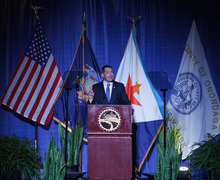Monumental flop: Star-studded cast fails to improve film with rushed plot, lack of depth
Nate McClennan | Contributing illustrator
“The Monuments Men” tells the story of art collectors and experts going to the front of World War II to save some of humanity’s greatest works from utter destruction.
However, if the film itself was around during that time, it would have been left in the rubble.
Based on the book by Robert Edsel and Bret Witter, “The Monuments Men” introduces audiences to an obscure detail of World War II, but is unable to make a lasting impression about the importance of the artwork that the men saved from the hands of the Nazis.
The movie begins with George Clooney, who co-wrote the screenplay, directed and starred in the film, presenting to a group of high-level military officials about the importance of the artwork that has been stolen by the Nazis. Though they are skeptical about risking their lives for art, Clooney, as Professor Frank Stokes, eventually convinces the military to let him assemble a team that will travel to Europe to recover the artwork.
Though we are introduced to Clooney’s co-star Matt Damon nicely, the rest of the team is largely glossed over, leaving the audience wondering about why they were chosen and how they grew as a group. Unfortunately, the audience never gets a proper introduction to the rest of the ensemble cast, which features standout actors such as John Goodman and Bill Murray.
The unit, composed almost entirely of men considered too old too fight, is clumsily rushed through basic training and then largely split up across Europe. Though the real monuments men did divide and conquer, Clooney and the rest of the writing and directing teams could have allowed the group to bond onscreen in order to show their camaraderie.
Another flaw in Clooney’s direction was the usage of characters, starting with himself. His character, Frank Stokes, transitions from a professor into a commanding officer too quickly and too easily to believe. Additionally, Clooney shows very little depth, which is shocking for an actor of his prominence. Stokes never looks distressed or worried in the face of enemy soldiers, always looking unflappable in aviator shades, even in the midst of war scenes.
Though the vignettes were entertaining, it was hard to keep track of who was where and which significant pieces they were specifically looking for. Bill Murray and Bob Balaban, who played experts Richard Campbell and Preston Savitz, respectively, demonstrated great chemistry onscreen in one of the film’s better moments, but the rest of it was bogged down by constantly bouncing around Europe.
Damon gave a solid performance as James Granger, the Metropolitan Museum of Art’s curator. However, the character of Granger was also largely removed from the rest of the group, as he was assigned to help the French resistance determine where the Nazis were taking much of Paris’ art. Much of Granger’s focus was to convince the Parisian Jeu de Paume Museum’s curator, Claire Simone (Cate Blanchett) to help the Americans. Blanchett put in a solid showing as Simone, who was hesitant to assist Granger in locating the lost artwork following the death of her brother, who was shot trying to steal artwork back.
Though Granger did eventually earn Simone’s trust, it seemed rushed, as Simone is mostly curt with Granger until the night before he leaves Paris, when she invites him over for a formal dinner. Clooney and the rest of the team may have wanted to include a romantic element to the film, but it was altogether too rushed and unnatural in this circumstance.
Lastly, the dialogue was exceedingly cliché. It seemed that each time the film would transition, Clooney and Grant Heslov, who also co-wrote the film, attempted to wrap up the scene with a striking line or phrase. However, instead of carrying the film forward or leaving memorable lines, these closures became boring and repetitive as the movie wore on.
In interviews about the film, Clooney stated that he and his team “wanted to make an epic.” Instead, however, “The Monuments Men” falls flat with a dispersed plot, unfounded characters and a script that searches for taglines instead of meaning.
Perhaps the works of Vermeer and Dali were worth risking lives for, but Clooney’s brainchild? Let it burn.
Published on February 18, 2014 at 10:40 pm
Contact Vincent: vtloncto@syr.edu





